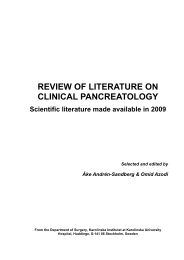Download PDF - The Pancreapedia
Download PDF - The Pancreapedia
Download PDF - The Pancreapedia
You also want an ePaper? Increase the reach of your titles
YUMPU automatically turns print PDFs into web optimized ePapers that Google loves.
females showed no significant differences<br />
between secretin- and pancreozymin-treated<br />
animals. Periods 3 (six to 10 hours) and 4 (10 to<br />
20 hours) exhibited no significant differences<br />
between the two treatments for either sex.<br />
Protein concentration was two to three-fold<br />
greater in pancreozymin-treated animals than in<br />
those treated with secretin in periods 1 and 2 in<br />
both sexes. Secretin-treated hamsters remained<br />
relatively constant in terms of protein<br />
concentration in secretions throughout the entire<br />
collection period. Large differences were also<br />
seen in sodium concentration between secretin-<br />
and pancreozymin-treated animals, with<br />
pancreozymin treatment eliciting about two and a<br />
half times as much sodium. K + concentration was<br />
40 to 50% lower in the case of secretin<br />
stimulation, as was Ca ++ concentration and Mg ++<br />
concentration. Chloride and bicarbonate were<br />
similar in the case of treatment by either hormone,<br />
whereas sulfate values were 60 to 90% of those<br />
for pancreozymin. Phosphate, on the other hand,<br />
was two times the value of pancreozymin-<br />
stimulated juice in the case of secretin stimulation.<br />
Electrophoresis showed a pattern similar to that in<br />
untreated animals (see above). Secretin<br />
depressed DNA synthesis but had little effect on<br />
RNA synthesis and slightly depressed protein<br />
synthesis in the entire pancreas. Pancreozymin<br />
appeared to have no effect upon DNA synthesis<br />
but seemed to stimulate RNA synthesis.<br />
Pancreozymin did not affect protein synthesis 90, 91 .<br />
5c. Pattern of Pancreatic Secretions in<br />
Aging Hamsters<br />
Pancreatic secretions were collected at eightweek<br />
intervals from eight weeks to 28 weeks of<br />
age and analyzed for all of the aforementioned<br />
parameters, exclusive of DNA, RNA, and protein<br />
90,91<br />
synthesis . <strong>The</strong> pH remained relatively<br />
constant in all of the collections. <strong>The</strong> flow rate was<br />
either similar to eight-week values or lower in all<br />
but three instances. Twelve-week-old male<br />
hamsters had a flow rate higher than that that of<br />
eight week-old at the 0 to 3 hour collection period.<br />
<strong>The</strong> 28-week-old male hamster had higher than<br />
28<br />
baseline flow rates at six to 10 hours and 10 to 20<br />
hours.<br />
i. Protein concentration was at least five times<br />
higher than the eight-week baseline values in<br />
12-, 20- and 28-week-old animals.<br />
ii. Na+ concentration was higher by approximately<br />
2.5-fold in hamsters at the 12th<br />
week. At 20 and 28 weeks, the Na+ concentration<br />
was similar to the baseline.<br />
iii. K+ concentration was lower than the baseline<br />
in the collections from the12-week-old female<br />
controls during all collection periods. In the<br />
corresponding male controls, K+ was higher in<br />
the collection at 0 to 3 hours, similar in the<br />
three to six hours and six to10 hour periods<br />
and slightly lower in the 10 to 20 hour<br />
collection. <strong>The</strong> K + concentration was<br />
significantly lower in all collection periods in<br />
both sexes with values around one-fourth<br />
those of the baseline, in 20-week-old<br />
hamsters. Twenty-eight-week-old hamsters<br />
showed values for K + which were 1/10 those<br />
of the baseline values throughout.<br />
iv. Ca++ values were also lower during all<br />
collection periods in 12-, 20-, and 28-week-old<br />
hamsters with 12-week values being one-half<br />
that of the baseline, and with 20- and 28-week<br />
values being about one-fifth of baseline<br />
amounts.<br />
v. <strong>The</strong> tendency was for magnesium values to<br />
become lower from 12 to 28 weeks as well.<br />
vi. Bicarbonate values were lower at 12 weeks of<br />
age, being one-fourth those of baseline values<br />
for both sexes through all collection periods.<br />
During the 20th week, hamsters exhibited<br />
amounts of bicarbonate which were about<br />
one-sixth those of the baseline, while the<br />
amount of bicarbonate increased to one-third<br />
of baseline values in all 28-week collections.<br />
vii. Concentrations of chloride were similar to<br />
those of the baseline at 12 weeks, while at 20<br />
weeks all collections for both sexes were<br />
about 1.5-fold higher [except in period 1 (0 to<br />
3 hours) in which the values were almost












